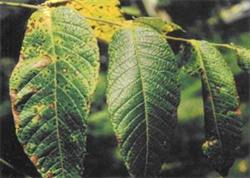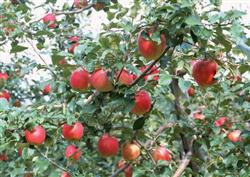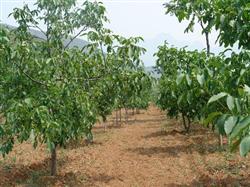What are the main diseases and insect pests of hickory?

What are the main diseases and insect pests of hickory? How should prevention and control be carried out? Please guide Carya cathayensis diseases and insect pests is an important factor affecting the yield of hickory, control of diseases and insect pests can play a role in protecting forests, promoting growth, increasing yield and so on. The common diseases of Carya cathayensis are branch blight and fruit tree rot. The common pests are hickory locust, Tianshe moth, hickory aphid, walnut leopard nocturnal moth, longicorn beetle (mulberry longicorn beetle, wrinkled green longicorn beetle, etc.). In recent years, some new insect pests have appeared, such as eye class hook moth, hickory flower bud maggot and so on. (1) Carya cathayensis disease control: 1. Carya cathayensis branch blight: Carya cathayensis branch blight is one of the important diseases of Carya cathayensis. It damages 1-year-old shoots and 2-year-old lateral branches, and spreads downward, causing big branches to die and weaken the tree potential and reduce the yield. The disease began in mid-late August and flourished from October to November. No new disease occurred from early March to early August, and all the dead branches were old disease branches left over from last year. The pathogen winters on diseased branches with mycelium and conidia. Conidia spread in the diseased forest from April to May and from September to October, and wind and rain was the transmission medium. Control methods: (1) in May, spray 70% methyl topiramate 500-700 times, or 1% Bordeaux solution, once every 15 days, three times in a row. (2) cut off the dead branches in spring and summer to prevent the disease from spreading downward in autumn and reduce the source of pathogens. 2. Carya cathayensis fruit tree rot disease: the disease mostly occurs on the main stem, main branch and lateral branch, and sometimes the base of the main root is also damaged. Symptoms: the bark of the diseased part rotted, and mostly occurred in the sunny side of the branches and branches, slightly raised at the initial stage, showing immersion, sunken by the bottom, the outline was long and oval, the diseased tissue was soft and rotten, black water flowed out, and the smell was scattered, causing the branches to die. Prevention and treatment methods: (1) in May, scrape off the diseased spot or remove the diseased branch in time, the main branch and side branch with early diseased spot, scrape off the surface of the diseased bark of the tree stem with a sharp scraper in time, and generally scrape off 1 mm of surface live skin until the white-green healthy skin is exposed. Pay attention to scraping off the diseased tissue, scraping off the diseased tissue and sawing off the seriously diseased branches or the dead main rod in time, take out the orchard and burn it. (2) the wound of scraping diseased tissue should be sterilized with 5-10 degree stone sulfur mixture or 45% crystal stone sulfur mixture 20 times or Guofukang 10-15 times solution. (2) Pest control of hickory: 1. Hickory Tianshe moth: Hickory Tianshe moth, also known as pecan green worm, is a major pest that harms the leaves of hickory trees. The insect spans four generations a year, spends the winter with pupae on the surface, feathers in the middle of April of the following year, mates and lays eggs. The damage periods of the four generations are from early May to late June, from mid-July to late July, from early August to late August, and from early September to early October. Adults have strong phototaxis. The occurrence periods of adults of each generation are early April, late June, late July and late August, respectively. Prevention and control methods: (1) Biological control: Trichogramma is released from the first generation at the peak of eggs. (2) Chemical control: a, spray with 3700 times of 25% deltamethrin and 3000 times of Sodimethrin respectively. B, in the larval stage, omethoate, poison silk and other internal inhalation pesticides were drilled and dripped. (3) artificial digging of pupae in pupa stage. (4) Light trapping in adult stage. 2. Carya cathayensis aphids: aphids occur all the year round in the producing area of Carya cathayensis. If aphids gather on the young buds, leaves and shoots of Carya cathayensis to suck juice, the bud leaves will wither, the male flowers will die, the female flowers will not bloom, and the tree potential will be weak. It seriously affected the yield of hickory in the same year and the following year. This worm has four generations a year. The first and middle of April was the most harmful period, with 1-3 generations of overlapping hazards. This period is also the most harmful to Carya cathayensis, which coincides with the sprouting, spring shoot growth and flowering of Carya cathayensis, so the control should grasp this period. Prevention and control method: that is, before and after Ching Ming Festival, 40% omethoate is used to punch holes in the tree stem at 1:0 or 1:1 concentration and injection will be effective. 3. Walnut leopard nocturnal moth: this insect occurs in every hickory producing area in Linan. When it is serious, the forest is like a fire, and a large number of hickory fruits are lost and reduced production. This insect has four generations a year, forms cocoons and pupates on the litter or grass of Carya cathayensis for the winter, and adults Eclosion in the middle of May of the following year. The damage periods of the four generations of larvae are from late May to early July, from late July to early August, from late August to mid-September, and from early October to mid-October. The emergence stages of adults are mid-May, mid-July, mid-August and mid-September, respectively. Adults have strong phototaxis. Control methods: (1), larval stage control: a, spraying the crown with 3000 times of permethrin, B, drilling holes with omethoate at 1:1, and C. in the morning and evening when there is no wind or breeze, a large area of damaged forest can be fumigated with "Lindane BHC" aerosol. (2) trapping and killing with light in the adult stage. 4. Imitation of grasshoppers: grasshoppers are a new pest that harms the leaves of hickory, commonly known as grasshoppers. The worm overwinters as eggs in topsoil, and hatches nymphs in mid-May of the following year. The peak hatching period is from late May to early June, adults Eclosion in early August, mating and laying eggs in late August, and adult death in late October. The first instar nymphs harm small shrubs and weeds while the second instar nymphs harm the leaves of Carya cathayensis. When adults enter the sexual maturity stage, they go down to the ground one after another, mate and lay eggs. Fresh human feces and urine have a special attraction to adults. Prevention and control methods: (1) Prevention and control of young nymphs: quick-killing ground spray of 1Ru 1500-2000 times liquid can be used, because the young nymphs mainly endanger firewood and weeds at the foot of the mountain and the surface, showing aggregation and distribution, and the ground concentrated spray has great lethality. (2) adult stage control: A. trapping method: Rice straw soaked with 90% crystal trichlorfon urine solution is stacked on woodland with grasshopper activity, 10 meters a pile, 6-7 mu (1-1 per pile of dried rice straw, 5Kg, trichlorfon 0, 2Kg, urine 25Kg). B, spray method: spray control of ground spawning under the sexual maturity of grasshoppers. From July to August, when a large number of grasshoppers go to the trees to mate but do not lay eggs, use 1500 times quick-killing spray. 4. Green-legged re-exposed locust: green-legged re-exposed locust is another locust that once broke out in Carya cathayensis forest area. The insect overwinters as eggs in topsoil in a year. The newly hatched nymphs appear in mid-April, adult Eclosion in early July, mating and oviposition in mid-July, and adults begin to die in late August. The newly hatched nymphs feed on plants such as Gramineae and Leguminosae. Trees from the second instar endanger the leaves of hickory, and fresh human feces and urine also have a special attraction to adults. Adults fly from trees to the ground and roadside weeds to lay eggs. Control methods: (1) ground spraying method: in the peak period of egg hatching in late April, 1500-2000 times liquid was sprayed on the ground. (2) trapping and killing adults with trapping heaps in July. The method is the same as the method of prevention and treatment of grasshopper. Click to get more hickory planting techniques click to get more fruit planting techniques
- Prev

How to prune apple trees in summer
How to prune apple trees in summer? Please guide the summer pruning of apple trees, also known as growing period pruning. Pruning during the growing period will cut off leafy branches, which has a greater impact on the growth of fruit trees, so it should be as light as possible. In addition, summer pruning is an auxiliary work of winter pruning.
- Next

What is walnut branch blight?
How to plant walnuts efficiently? Please give guidance on walnut planting can refer to the following planting methods: seedling selection: high-quality seedlings should be selected. High-quality seedlings refer to pure varieties, good interface healing, more than 15 lateral roots, more than 1.2 cm basal stem, more than 60 cm high seedlings, smooth seedlings, no damage and diseases and insect pests.
Related
- Moge, come on! The staff of the peasant association in the producing area of cantaloupe were frightened when the crowd gathered.
- Causes and Solutions of low Fruit setting rate of Apple
- Symptoms and control measures of passion fruit virus disease
- Fruit growing lesson: how do apple orchards keep high yields?
- Can you build orchards in the mountains? What are the pros and cons?
- How to manage the coloring period of Crisson grape?
- This paper introduces the processing technology of two kinds of fig products.
- How much is a month for retired teachers in rural areas by 2020?
- How can strawberry planting increase sugar content? We should pay attention to management in many aspects.
- What are the cultivation techniques on how to improve the yield of golden fruit?

